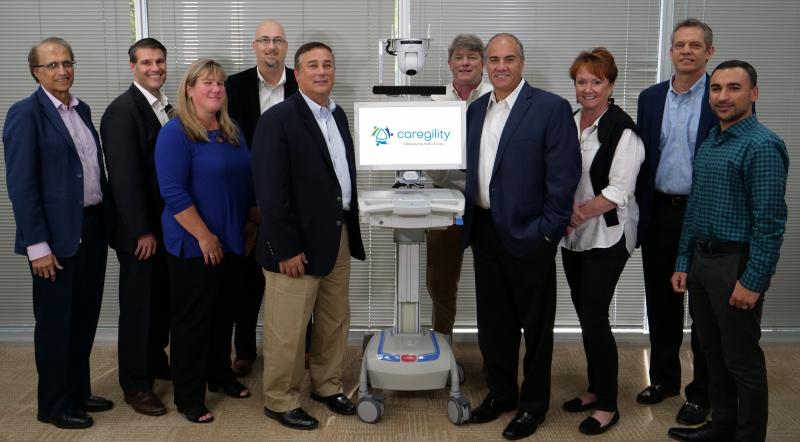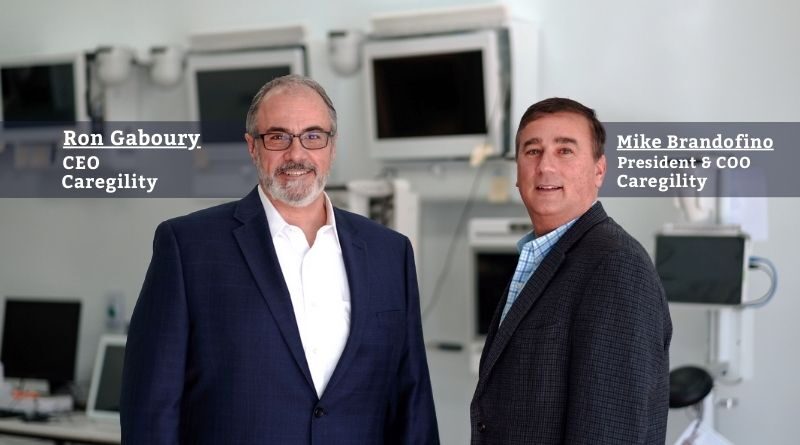CAREGILITY-Telehealth Meets the Moment, and Keeps Going
Over a year ago, as the COVID-19 pandemic’s scope became clear, Caregility quickly rolled out software that could run on everyday phones and computing devices, powering virtual healthcare encounters, remote patient monitoring, and patient/family communication.
Early Caregility provider success stories included curbside emergency department patient triage, off-site COVID-19 testing, and drive-through behavioral health visits. The company helped one Florida-based health system to scale up to more than 1,000 daily telehealth sessions within a week, the same timeframe in which another health system was able to implement 60 new eICU beds with Caregility’s support.
Architecture that Supports the Continuum of Care
The last thing time-starved facilities need is another complex telehealth application to train staff on and support. Thus, Caregility strives for maximum ease-of-use and interoperability. For example, context-aware links within platforms such as Epic and Philips eCareManager allow clinicians to quickly add participants, who can join from their device of choice without additional apps or logins. Caregility’s platform is compatible with all major EMRs and an array of clinical workflows and decision support applications.
Caregility’s iConsult module, available on desktop and mobile iOS and Android devices, enables virtual rounding, assessments, and patient/family visits.
Caregility’s interoperability is facilitated through a flexible cloud architecture, in which interaction with multiple EMRs, ancillary systems, and clinical applications occurs via a simple API set on iOS, Android, Windows, and Linux devices. The platform leverages WebRTC and standards-based video protocols, such as SIP and H.323. The Caregility Virtual Care Platform, which recently earned a “Best in KLAS” Award (Virtual Care, Non-EMR), is backed by full HIPAA compliance and security optimized by patented single-use call instances, AES-256 encryption, and other safeguards.
Caregility’s iConsult module, available on desktop and mobile iOS and Android devices, enables virtual rounding, assessments, and patient/family visits. The iObserver application controls carts and wall/ceiling units, as well as freestanding tablets, used for remote observation and patient interaction. At Caregility sites, clinicians can use mobile devices for both purposes.
Taking Remote Monitoring & Virtual Observation Beyond the ICU
The cost-effectiveness of virtual “sitting” with patients at risk, rather than a 1:1 in-person staff commitment, is well-established. As facility access protocols and patient loads shift, the benefits of robust, easy-to-wheel devices that can be quickly added to remote workflows are clear. Caregility CEO Ron Gaboury notes that Caregility’s iObserver remote monitoring module is applicable to many long-term care, assisted living, and sub-acute care settings, which are often constrained by financial considerations when setting staff ratios.
Caregility’s iObserver application and devices focus on functionality that is meaningful for patients, family members, and the care team. The module supports continuous annotated observation of up to 12 patients on one screen, with on-site alerts and responses automatically logged.
To reduce staff burden, in addition to routine operation, Caregility’s point-of-care device settings can be changed remotely as well, including an auto-answer option to reduce disinfection concerns and physical demands on patients. Night vision features support more restful sleep. Video cameras have simple, intuitive pan/tilt/zoom control, including click-for-a-still-photo, accessible from any mobile device or computer. Whether a clinician needs to see an IV pump in closeup, or a family member wants to zoom in on a patient’s face, iObserver supports that virtual encounter functionality.
Building in a Clinical Context
“Unlike other solutions we’ve seen,” Caregility CEO Ron Gaboury explains, “our platform was purpose-built by and for clinicians.” He mentions Wendy Deibert, BSN, EMBA, Senior Vice President for Clinical Solutions, who formerly led the country’s largest eICU (Mercy).
“Wendy and her team ensure that our virtual care solutions fit seamlessly into real-world workflows across the continuum of care to ensure that we save clinicians precious time,” Gaboury notes. “Our clinical and IT teams work together to implement resources that avoid instances where a client doesn’t have the right cabling or there are fixed patient care devices or utilities in the way.”
That upfront diligence has paid off, literally, according to Gaboury. “Now that we’ve hosted more than two million encounters at nearly 10,000 access points, we’re fulfilling the ROI that our clients have a right to expect, while still delighting individual users with how easy the technology is. Our admin portal provides point-and-click reports with key metrics on everything from call quality and bandwidth use to which carts are used when.
“These reports quickly highlight any underutilized resources that can be reassigned, or a need to increase device count. With our flexible licensing structure, clients don’t pay for more users than they need, and can show the C-suite that our platform is accomplishing what the clinical units and operations said it would.”

“Much More than a Video Call”
Spun out from a telecommunication provider in 2019, Caregility’s only mission is providing simple, secure connectivity that supports optimal health and wellbeing. Caregility President and COO Mike Brandofino is quick to confirm that 2020 was only the launch of Caregility’s roadmap.
“Telehealth is now so much more than a video call in lieu of in-person care. Our platform supports secure, decentralized virtual care, communication, and coordination at scale. As COVID, we hope, becomes more of an endemic disorder, we will work with clinicians and IT alike to address chronic condition prevention and management, which are often the keys to health status, adverse events, and spend.”
Brandofino notes that Caregility will continue to support site-of-care interventions that minimize viral transmission, along with monitoring for other safety issues such as falls, violence, and substance abuse.
Data Transformation for Better Health
Wearables, patient-generated data, and connected medical devices are providing more potentially useful clinical data than ever. However, fulfilling the promise of connected care requires the reconciliation of conflicting information, while appending the new and updated information that can drive improved decisions.
Accordingly, Caregility’s platform is being engineered over time to support emerging innovations that can improve patient-reported and clinical outcomes. These include:
- Integration of facility communication and call systems and EMR and decision support tools, both in and out of virtual encounters
- Voice-activated clinical workflows and algorithmic call routing, wherever clinicians and staff are located
- “Smarter” point-of-care cameras, powered by software that allows for real-time interpretation and alerts
- Location-agnostic, AI-powered biometric and health behavior capture and analysis, with appropriate risk stratification and monitoring
- Integration with wearables, chatbots, and connected medical devices in homes and provider settings
At the highest level, Brandofino suggests, interoperable platforms present a critical opportunity to see a patient on screen or in person, and also see real-time and historical variables in a single view.
Caregility’s ongoing commitment to interoperability and a useful feature set spawned numerous 2020 integrations, with more underway. The company’s near-term focus is on AI benefits for clinical care and global outreach.
It’s All Connected
“Connected care has earned its place in the health care ecosystem,” Gaboury concludes. “Facilities of all sizes and at all levels of care can now leverage virtual care infrastructure.”



